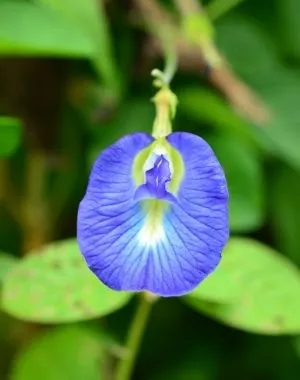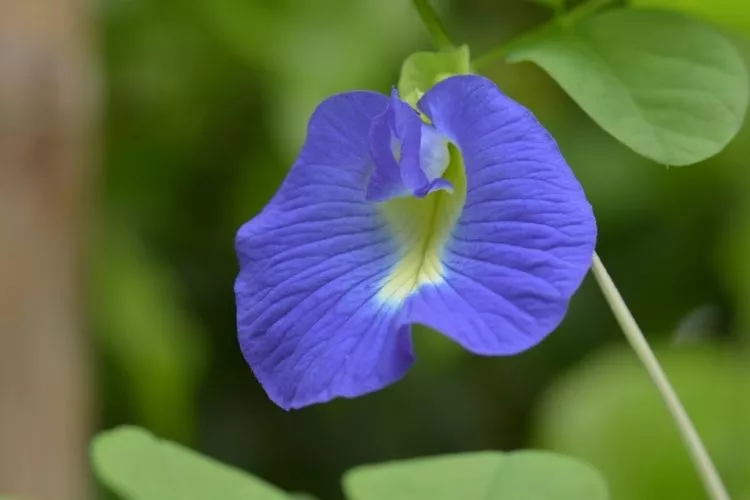The butterfly pea flower is known for its splendid blue flowers, low-maintenance care and edible blossoms popular for making tea.
And don’t forget that it’s a favorite for pollinators- especially butterflies. No surprise there, given its common name!
Today, you’ll learn the details of how you can add some spectacular blue color to your flower garden. We’ll also cover some butterfly pea plant background information and how you can dry your flower harvest for tea.
Table of Contents
What Growing Conditions Does Butterfly Pea Flower Need?
Once you’ve got healthy seedlings established, the blue butterfly pea is very easy to grow and is a perfect example of a no-fuss plant.
There are five main categories to address when learning about how to grow butterfly pea flower:
- Soil
- Water
- Sunlight
- Temperature
- Support
Let’s look at each one in greater detail:
Soil: Butterfly pea plant isn’t too picky when it comes to soil. But one thing that it does require is good drainage.
If you’re growing in a container, make sure it has at least two drainage holes. Also, use light, well-draining potting soil to fill your container.
This organic option is nice if you plan on eating or making tea with your flowers.
For in-ground growing, choose a location that doesn’t get standing water. If you have heavy clay soil, lighten it up with some compost, last autumn’s chopped leaves or other organic matter.
As far as soil type, pretty much any kind is acceptable to the butterfly pea plant. While it does prefer acidic soil, even sandy, nutrient-poor soil will suffice.
This soil acidifier can help you create the very best home for your new plant.
Water: Thankfully, these beautiful vines are actually quite tolerant to drought. Once established, butterfly pea plant only needs water when the weather is hot and dry.
However, newly-planted butterfly pea flower seedlings need regular watering at first. Once you see new growth emerging, you can cut back to an as-needed basis.
Sun: As a tropical native, butterfly pea plant loves sunshine, and it prefers to grow in full sun.
But it can also tolerate partial shade, albeit with fewer blooms for you to enjoy.
If you’ve got a space in your garden and even a little light, it should grow.
Temperature: Butterfly pea flower really likes humid conditions with temperatures above 60o F, although 75o to 89o F is optimal.
Most areas of the United States should be able to support butterfly pea flower during the summer. But it is not frost-hardy at all, unfortunately!
Support: This vine can grow large: Up to 10 feet high and 2 to 3 feet wide!
A trellis, archway or even a shrub or bush is essential to keep things tidy.
But if you’re like me and you like dramatic vines spilling over the sides of pots, a hanging basket on your porch would be another great option!
Wherever you end up planting your butterfly pea plant, this multi-talented plant does more than just look great. As a legume, it also enriches your soil by producing and releasing nitrogen.
And that’s a great thing for all the plants in your garden!

How to Plant Butterfly Pea Seeds
Now let’s move on to the topic of how to plant butterfly pea seeds.
Unfortunately, butterfly pea flower typically does not have a high germination rate. So always buy more seeds than you think you need.
Here are a few steps that can help increase your seeds’ rate of success:
Step 1: Start with aged, healthy seeds. These should appear black or dark brown, round, and firm.
Check for their health with the water test. Place your seeds in a glass of water, and after about 15 minutes or so, the healthy seeds will float.
After your float test, don’t remove your seeds from the water just yet! Which leads to the next step…
Step 2: Allow the seeds to soak for up to 24 hours in room temperature water.
You can also nick the seeds to assist in water absorption. This means that you take a sharp utility knife and make one gentle slice through the seed’s outer coat.
Nicking helps break through the seed’s tough outer shell, allowing water to get to the inner core and giving the new seedling an easier escape route.
Step 3: If planting in containers, make sure the pots are at least six inches deep to accommodate the root ball and allow for growth.
Step 4: Place the soaked seeds in your prepared pot or garden one inch deep and at least four to six inches apart.
Step 5: Until the seedlings appear, keep the soil moist but not soggy.
It may take up to 30 days for your butterfly pea flower seedlings to make their appearance, so be patient!
If you’ve started your seeds in their permanent home in-ground or in a pot, your work is done!
Otherwise, move on to step 6.
Step 6: Once your seedlings have at least three sets of true leaves, they’re ready for transplanting.
This is a delicate process since butterfly pea flowers are pretty sensitive to having their root ball disturbed. So make sure to go slowly and use gentle motions.
Start with a moist root ball and be sure to dig a hole deep and wide enough to accommodate this tender seedling.
Place your hand over the container top with the seedling in between your middle and ring fingers. Turn the container upside down, and tap the bottom and sides of the container to help the root ball slide out.
Then settle your seedling into its new home, fill the hole with soil and gently firm it down. Finally, water your new butterfly pea flower well.
RELATED: There are many lovely flowers with bell shaped blooms to plant in your garden- get some inspiration from my list of favorites!
Where to find Butterfly Pea Seeds
Butterfly pea plants aren’t the most common flowers, so you probably won’t see seeds for sale at grocery or big-box store displays.
Online retailers are your best bet, with Etsy being a particularly great resource with dozens of options. Visit Etsy here to see the many vendors selling them.
Amazon has a few options to choose from, including these from The Clayton Farm and these from Papcool.
Occasionally, you may be able to find some of these products at your local garden centers or home improvement centers. If you don’t see them, it’s worth asking if they can be special-ordered.
Remember: We mentioned earlier that butterfly pea flowers don’t have a high germination rate, so make sure to purchase extra seeds.
How to Grow Butterfly Pea Flower from Cuttings
Starting your own plant from a stem cutting is a great way to speed the process up and skip the seed stage altogether.
If you know someone who grows butterfly pea flower in their garden, ask if you can take a cutting. Consulting any local gardening groups can be another way to get your hands on a healthy cutting.
SIDE NOTE: I have personally learned so much from being a part of local gardener’s groups on social media. If you’re not already connected to a local group in person or online, I can’t recommend it highly enough!
When taking your cuttings, always cut from an older, more-established part of the plant for greater success in propagation.
Make your cuttings at least 3 to 5 inches long with the lower leaves removed and a bud at the top.
Place the cuttings in some fresh water for a week or two until roots appear, then transplant into your garden ground or a container.
You can also place the fresh cutting into soil, whether in-ground or in a container. If you live in a cooler climate, some powdered rooting hormone may help ensure that your cutting thrives.
As a vigorous grower, butterfly pea flower cuttings should form roots quickly. Once established, you should see blooms in about three weeks!

Potential Problems with Butterfly Pea Plant
The butterfly pea flower has a few pests and diseases that can affect it throughout the growing season:
Pests. These include the typical garden offenders:
- Aphids
- Spider mites
- Caterpillars
- Grasshoppers
Treat aphids and spider mites with insecticidal soap. Repeat the application a few times if necessary.
Pick off the larger insects by hand and remove affected leaves. As long as the damage isn’t severe and widespread, it shouldn’t affect the health of your butterfly pea plant.
Leaf discoloration. Even though butterfly pea flower isn’t too finicky when it comes to soil, yellowing leaves could signal a significant nutrient deficiency.
Apply a balanced fertilizer to give your plan the nutrition it needs.
Unruly growth. Much like other vines, if your blue pea plant starts looking leggy you can prune it to keep it looking full.
Making sure you have a good support structure can also help you maintain an attractive shape.
Butterfly Pea Background
This delicate flower vine is a native of South East Asia, commonly found in Vietnam, India, Thailand, Indonesia, and Sri Lanka.
There are about 35 different species within the family, and according to the U.S. Forest Service, there’s only one that grows native to North America.
The butterfly pea plant is known by many names:
- Clitoria ternatea (Latin)
- Blue butterfly pea plant
- Butterfly pea flower
- Asian pigeonwings
- Bluebellvine
- Darwin pea
Butterfly pea flower comes in a range of shades, including white, pink, purple and blue. But the most common, by far, is the deep royal blue color.
The beautiful blooms of this plant are edible, and so are the pea pods it produces.
It is a trendy food plant that in recent times has been used for promoting health and beauty, including weight loss, detoxification and improving hair growth and skin texture.
According to U.S. News, butterfly pea plant has been put to several uses:
- Cover gray hairs
- Dye fabrics
- Create color-changing cocktails
- Add a blue hue to foods
And to top it off, an article from MedicineNet lists several health benefits of butterfly pea flower, including:
- Boosting brain health
- Lowering blood pressure
- Inhibition of cancer growth
- Regulation of blood sugar
The butterfly pea plant is not only beautiful and great for tea, but it’s also beneficial to your health!
Drying Butterfly Pea Petals for Tea
If you’re an avid tea drinker, the butterfly pea plant will provide you with a surprisingly colorful and tasty tea made from dried petals.

Here’s how you can make your own homegrown tea!
Gather a handful or small bowlful of healthy, unblemished blossoms. If you have a food dehydrator, it’s perfect for drying the butterfly pea petals.
But if you don’t have one, that’s fine too! Place the flowers on a plate in a single layer and allow to dry for a few days until the petals are crisp.
Once dried, these flowers can be kept for up to a year for steeping in any season.
The blue pea petals can be made into tea all by themselves, but are also good with some dried lemongrass or chamomile.
For a fun color-changing trick, add some lemon or lime. This tea will change from a beautiful blue to an equally stunning purple.

Frequently Asked Questions about Growing Butterfly Pea Flower
Final Thoughts
The butterfly pea plant is a beautiful addition to any garden.
With its soil-enriching properties and health benefits, it’s not only nice to look at but can also benefit your body and other plants nearby.
Are you most excited to grow butterfly pea flower for its color, tea making or maybe both?
Let us know in the comments!

